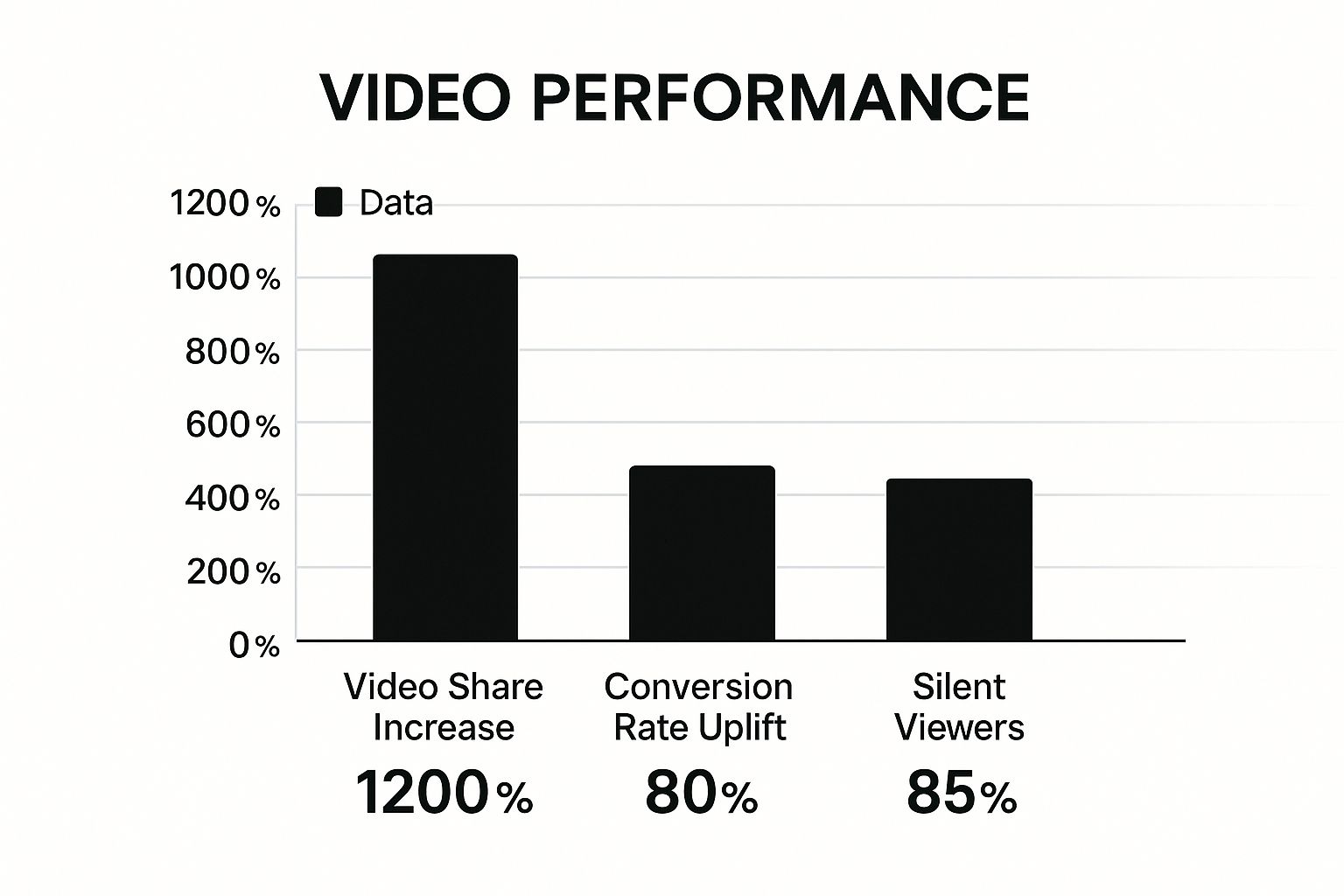In today’s crowded digital landscape, a generic approach to social media is a recipe for invisibility. Success isn’t about random posting; it’s about deploying calculated strategies that build communities, foster loyalty, and deliver measurable results. Forget guesswork and get ready to explore 10 proven social media strategies examples that top brands use to dominate their niches.
We’ll break down the ‘why’ and ‘how’ behind each one, providing a clear blueprint you can adapt to elevate your own social presence.These examples of social media strategy go beyond theory, offering a deep dive into the specific tactics, execution, and outcomes that make them effective. For a foundational understanding and steps to building your overall social media marketing game plan, refer to this guide to Build a Winning Social Media Marketing Strategy and explore our in-depth resource on content strategy for social media before diving into these specific examples.
This article is designed to be your practical playbook. From leveraging authentic user-generated content to mastering data-driven personalization, these actionable insights will equip you with the strategic edge you need to win in 2025 and beyond. Let’s move past simple metrics and unpack the social media marketing strategy examples that create real impact.
1. User-Generated Content (UGC) Strategy
A UGC strategy shifts the burden of content creation from your brand to your audience. Instead of producing all of your own marketing materials, you encourage customers and followers to share their authentic experiences with your product or service. This approach generates a powerful feeling of community and social proof, as individuals trust recommendations from peers far more than traditional advertising.
This is one of the greatest social media strategy examples since it leverages authenticity to build trust. When potential customers see ordinary people enjoying your products, it creates a relatable and interesting narrative.
Why It Works
Brands like GoPro and Apple have mastered this strategy. GoPro’s #GoPro campaign turns customers into brand ambassadors, showcasing thrilling, high-quality videos that perfectly highlight the product’s capabilities. Apple’s #ShotOniPhone campaign does the same, transforming its users into a global community of photographers who demonstrate the iPhone’s camera power through real-world imagery. This user-led approach fuels an endless stream of authentic, high-performing content.
UGC Engagement Boost: According to Synup’s 2025 Social Media Report, user-generated posts earn 8.7× higher engagement than branded content, making UGC one of the most effective ways to build trust, visibility, and brand recall organically.
How to Implement a UGC Strategy
To replicate this success, start by creating a unique and memorable branded hashtag. Actively encourage your followers to use it by running contests, offering features on your page, or providing exclusive discounts.
- Create a clear call to action: Tell your audience exactly what kind of content you want them to create and share.
- Always ask for permission: Before reposting any user’s content, get their explicit consent to respect their ownership.
- Engage and give credit: Publicly thank contributors and tag their profiles when you feature their content.
By making your customers the heroes of your brand story, you not only generate authentic marketing material but also foster a loyal and active community. For a deeper dive, you can explore more advanced User-Generated Content strategies to further refine your approach.
2. Influencer Partnership Strategy
An Influencer Partnership Strategy involves collaborating with social media influencers who have established credibility and an engaged audience within a specific niche. This approach leverages an influencer’s trusted voice to promote products or services, making brand messages feel more like authentic recommendations rather than direct advertisements.
This is one of the most powerful social media strategies examples because it taps into the trust that influencers have built with their followers. A recommendation from a respected creator can drive significant brand awareness and conversions.

Why It Works
Daniel Wellington and Gymshark are companies that have made their fortunes with this strategy. Daniel Wellington infamously partnered with thousands of micro-influencers, sending them a watch for free if they Instagrammed it, creating a viral aspirational movement. And Gymshark’s constant partnerships with fitness athletes and influencers have created an organic following, driving massive growth by showcasing their apparel in action with creators that their audience aspires to.
How to Implement an Influencer Partnership Strategy
Start by identifying influencers whose values and followers truly align with your brand. Favor long-term partnerships over single paid posts, consistency leads to trust and better results in the long term.
How to Get It Right:
Define clear goals: Know whether you’re seeking awareness, lead generation, or direct sales so that you can accurately measure success.
- Prioritize authenticity over reach: Micro-influencers with engaged but smaller communities will often outperform big names with dormant followers.
- Track performance: Use discount codes or affiliate links to accurately measure ROI and refine future collaborations.
- Stay compliant: Always follow FTC regulations, sponsored posts need to be transparent to protect you and the influencer.
By partnering with creators that genuinely embody your brand, you can access new audiences and build long-term credibility.For deeper insights, check out this guide on how to do collaborative posts on Instagram to maximize reach and engagement.
3. Social Listening and Real-Time Engagement Strategy
A Social Listening and Real-Time Engagement strategy entails actively monitoring social media for mentions of your brand, competitors, and key industry topics. It turns social media into a live, two-way conversation rather than a one-way broadcast. Brands can address customer issues in the moment, jump into trending discussions, and gain valuable insight into audience views by listening carefully.
This strategy works because it makes you agile and reactive. It generates brand affection by surprising and astounding individuals, anticipating potential crises before they even arise, and being culturally relevant in the moment.
Why It Works
This strategy is supported on being live and on time. Oreo’s legendary “You can still dunk in the dark” tweet during the 2013 Super Bowl blackout is a wonderful example of live marketing genius. Like with Wendy’s, which has accrued a massive following with its biting and “savage” Twitter comebacks, making mundane customer exchanges go viral. These kinds of brands capitalize on when opportunities arise, creating memorable and highly sharable content.
How to Implement a Social Listening Strategy
Start with tools like Sprout Social or Hootsuite to monitor brand mentions, competitor activity, and key terms in your industry. Be specific about exactly what you want to monitor, like your business’s name, common misspellings of your business’s name, and keywords associated with your business, to make your monitoring more accurate.
How to Execute Effectively:
-
Set up alerts: Get real-time notifications for your brand name and key phrases so you can respond quickly.
-
Create a response guide: Define your tone of voice and outline how to handle both positive and negative feedback.
-
Act fast: Timing is everything. Join conversations while they’re still trending to stay relevant and visible.
By actively listening and responding, you’ll build stronger relationships with your audience and turn social media into a goldmine of insights and engagement opportunities.
4. Content Pillar Strategy
A Content Pillar strategy organizes your social media content around 3-5 core themes, or “pillars,” that align with your brand’s values and your audience’s interests. This framework prevents your feed from becoming repetitive or one-dimensional by ensuring a consistent, yet varied, mix of educational, entertaining, and promotional posts. Each pillar acts as a central topic from which you can create numerous smaller, related pieces of content.
This is one of the most foundational example of social media strategy because it brings structure and purpose to your content calendar. It ensures every post supports your overarching brand narrative and business goals, making your content creation process more efficient and effective.
Why It Works
Brands like HubSpot and Patagonia excel with this strategy. HubSpot’s content is built on pillars like marketing tips, sales advice, and company culture, directly serving its professional audience’s needs. Similarly, Patagonia focuses on pillars such as environmental activism, product durability, and adventure stories, which reinforce its brand identity and resonate deeply with its community’s values. This structured approach builds authority and keeps audiences engaged.
How to Implement a Content Pillar Strategy
Begin by identifying your core themes based on audience research, brand values, and what you want to be known for. Use these pillars to guide your content creation, ensuring a balanced feed that consistently provides value.
- Define 3-5 core pillars: Choose broad topics that align with your brand mission and audience pain points.
- Create sub-topics: Brainstorm smaller ideas within each pillar to generate a steady stream of fresh content.
- Apply the 80/20 rule: Dedicate 80% of your content to providing value (education, entertainment) and 20% to promotion.
- Review and adjust: Analyze pillar performance quarterly to see what resonates most with your audience and refine your strategy.
By organizing your efforts around key themes, you create a cohesive and compelling brand presence that attracts and retains a loyal following. For a more detailed guide, you can learn about creating a content pillar strategy to streamline your workflow.
Visual-First Advantage: According to Synup’s data, posts that include images or graphics generate 10× more engagement than text-only updates. Integrating visuals across your content pillars ensures your educational or storytelling posts hold attention longer and rank better in algorithmic feeds.
5. Platform-Specific Optimization Strategy
A Platform-Specific Optimization strategy moves you away from a generic social media strategy. It’s an admission that each platform has its own audience, algorithm, and accepted content format. Instead of cross-posting the same message everywhere, you tailor your content to fit the native environment of each channel, maximizing engagement and impact.
This is one of the most significant social media strategy examples because it respects the user’s context. Users on LinkedIn expect professional knowledge, and users on TikTok expect raw, short-form entertainment; delivering the right content in the right place builds a more engaging connection.
Why It Works
Brands like Duolingo and The Washington Post are having success with this approach. Duolingo’s TikTok is famously known for its racy, meme-y ads for its owl mascot, Duo, that perfectly match the platform’s younger, trend-savvy user base. Its Twitter account, on the other hand, is where it shares more straightforward app notifications and teaching content. The Washington Post, similarly, uses TikTok for humorous, behind-the-scenes spoofing, while its Facebook page remains a source for serious, in-depth news coverage.a
How to Implement a Platform-Specific Optimization Strategy
Begin by analyzing the distinct user behaviors and top-performing content formats on each of your target platforms. Adapt your core message to fit these unique environments rather than simply reposting.
- Analyze each platform’s culture: Understand the unwritten rules and user expectations for Instagram, TikTok, LinkedIn, Twitter, and Facebook. If Pinterest is part of your mix, using a reliable Pinterest post scheduler can help you stay consistent and take advantage of its visual discovery algorithm.
- Adapt content formats: Repurpose a single idea into multiple formats, such as a professional article for LinkedIn, a quick visual tip for an Instagram Reel, and a conversational thread for Twitter.
- Tailor your brand voice: Allow your brand’s personality to adapt. It can be more professional on LinkedIn and more playful and informal on TikTok.
By tailoring your content, you show your audience that you understand and respect the platforms they choose to spend their time on. This nuanced approach demonstrates savvy and authenticity, leading to higher engagement and more meaningful community growth.
Cross-Platform Overlap: Meta’s 2025 audience study found only 26% audience overlap between Facebook and Instagram users. Tailoring your message per platform isn’t optional — it’s the only way to reach unique segments effectively without content fatigue.
6. Community Building and Engagement Strategy
This strategy focuses on turning passive followers into loyal advocates. Community building is among the most sustainable social media strategy examples, emphasizing long-term relationships over quick wins.
A Community Building and Engagement Strategy focuses on nurturing an active, loyal community around your brand, moving beyond simply gaining followers. This approach prioritizes meaningful two-way conversations and peer-to-peer interactions, creating a genuine sense of belonging. The goal is to transform a passive audience into brand advocates who participate, provide feedback, and support the brand organically.
This is one of the most sustainable social media strategies examples because it builds long-term loyalty. Instead of chasing fleeting trends, you invest in relationships that strengthen your brand from the inside out.

Why It Works
Brands like Peloton have excelled at this by creating a passionate community of riders who support and compete with each other. Similarly, Sephora’s Beauty Insider Community serves as a hub where millions of members share advice and product reviews, strengthening customer loyalty. This strategy provides invaluable social proof and turns customers into an integral part of the brand’s ecosystem.
Cross-Platform Spillover Effect: A 2025 Springer study found that community interactions on one platform can drive up to 18% increased engagement on other connected platforms — meaning conversations in your Facebook group can lift visibility on Instagram or X.
How to Implement a Community Building Strategy
To build your own community, focus on creating dedicated spaces and fostering authentic interactions. The key is to facilitate connections, not just broadcast messages.
- Create a dedicated space: Use platforms like Facebook Groups, Discord servers, or dedicated forums to give your community a home.
- Prioritize two-way conversation: Respond personally to comments and messages, host regular Q&As, and actively listen to feedback.
- Empower your members: Feature community members in your content, celebrate their achievements, and create exclusive perks for active participants.
To expand on this approach and discover practical ways to nurture relationships online, explore our dedicated guide on community building strategies.To explore this further, you can discover more about how to build online communities and strengthen your brand’s foundation.
7. Employee Advocacy Strategy
An Employee Advocacy strategy transforms your workforce into a powerful team of brand ambassadors. Instead of relying solely on corporate social media accounts, this approach encourages employees to share company-related content, news, and personal insights on their own social networks. This humanizes your brand and leverages the authentic trust people place in their peers over official company channels.
This is one of the most powerful social media strategies examples for organic growth because your employees’ collective network is often far larger than your brand’s. Their genuine posts can significantly expand your reach, boost engagement, and build credibility from the inside out.
Why It Works
Companies like Dell and Adobe have demonstrated the immense impact of employee advocacy. Dell’s program has reached hundreds of millions of people, driving significant traffic and leads by empowering its team to share content they find relevant. Similarly, Adobe’s program created a massive surge in social engagement by making it easy for employees to act as thought leaders and brand advocates, showcasing a positive and innovative company culture. This strategy taps into the most trusted marketing source: people.
How to Implement an Employee Advocacy Strategy
To launch a successful program, focus on empowerment rather than obligation. Provide your team with the tools and content they need to feel confident sharing, but always keep participation voluntary to maintain authenticity.
- Provide clear guidelines and training: Offer simple social media guidelines so employees understand best practices without feeling restricted.
- Create a content hub: Make it easy for employees to find and share pre-approved content like blog posts, industry news, and company updates.
- Recognize and reward participation: Acknowledge top advocates through internal shout-outs, small incentives, or professional development opportunities.
By turning your employees into trusted advocates, you build a scalable and authentic marketing engine that attracts both new customers and top talent.
8. Video-First Content Strategy
A Video-First Content Strategy prioritizes video across all social media platforms, acknowledging its superior ability to capture attention and drive engagement. This approach leverages formats like TikToks, Reels, and YouTube Shorts to align with modern consumption habits, where users prefer dynamic, visual storytelling over static posts. Brands use video to entertain, educate, and build a deeper connection with their audience.
This is one of the most powerful social media strategies examples because video is favored by algorithms and audiences alike. It leads to higher reach, retention, and conversion rates, making it an essential tool for growth.
The following infographic highlights key data points that underscore the impact of a video-first approach.

This data clearly shows that video not only gets shared more but also significantly boosts conversions and is frequently consumed without audio.
Why It Works
Brands like Red Bull and Tasty (a BuzzFeed brand) have built empires on this strategy. Red Bull’s high-octane extreme sports videos generate millions of views, perfectly embodying its energetic brand identity. Tasty pioneered viral, overhead cooking videos that are simple, satisfying, and highly shareable, creating a new genre of food content. Similarly, Dollar Shave Club’s hilarious launch video went viral, proving that a single well-executed video can build a multi-million dollar company.
How to Implement a Video-First Strategy
To adopt this strategy, focus on creating content native to each platform’s video format. Prioritize short-form, vertical video for mobile-first audiences and invest in good audio and lighting to ensure a quality viewing experience.
- Hook viewers immediately: Capture attention within the first three seconds to stop them from scrolling.
- Add captions: Since up to 85% of videos are watched on mute, captions are essential for accessibility and message delivery.
- Repurpose content: Break down long-form videos like webinars or interviews into dozens of short, shareable clips for platforms like Reels and TikTok.
By putting video at the core of your content plan, you tap into the most engaging medium on social media, driving brand visibility and audience loyalty. For more inspiration, you can review some of the best video marketing campaigns to see how top brands succeed.
Video Engagement Advantage: A ResearchGate study found that short-form vertical videos drive 2.4× more interactions than still posts, and platform-native video strategies outperform generic content syndication by 37%. Investing in original video pays off exponentially.
9. Data-Driven Personalization Strategy
A data-driven personalization strategy uses audience analytics and behavioral data to deliver highly tailored content. Instead of broadcasting a single message to all followers, this approach segments your audience and creates customized experiences that resonate with their specific interests, past behaviors, and position in the customer journey. It transforms your social media from a megaphone into a one-on-one conversation.
This is a powerful example of social media strategies because it directly increases relevance, which in turn boosts engagement and conversions. When users see content that speaks to their individual needs, they are far more likely to pay attention and take action.
Why It Works
Spotify’s annual #SpotifyWrapped campaign is a masterclass in personalization. It provides each user with a shareable summary of their unique listening habits, creating a viral event that feels deeply personal. Similarly, Netflix tailors its social media promotions based on regional viewing data, ensuring its content recommendations align with local tastes and popular shows. This makes their marketing feel less like an ad and more like a helpful suggestion from a friend.
How to Implement a Data-Driven Personalization Strategy
Begin by using platform analytics tools, like the Meta Pixel, to understand your audience’s demographics and behaviors. Segment your followers into distinct groups based on interests, purchase history, or website interactions. For advanced strategies that leverage user data to re-engage potential customers, exploring the principles of retargeting in marketing can significantly boost your campaign effectiveness.
- Utilize custom audiences: Create targeted ad campaigns for specific segments, such as recent website visitors or email subscribers.
- A/B test your messaging: Experiment with different ad copy, visuals, and calls to action for each segment to see what resonates most.
- Integrate your CRM: Combine social media data with your customer relationship management (CRM) system for a complete view of each customer.
By tailoring your content to the individual, you build stronger connections, increase loyalty, and drive more meaningful results from your social media efforts.
Format Performance Insight: A 2025 study analyzing 1.3 million brand posts revealed that carousel posts earn 1.92% average engagement, outperforming both static images and single videos. Applying these insights to your personalization efforts can drastically improve results.
10. Purpose-Driven Social Activism Strategy
A Purpose-Driven Social Activism strategy involves aligning your brand with social, environmental, or political causes that resonate with your core values and audience. Instead of focusing solely on product promotion, your brand uses its platform to advocate for meaningful change, building a deeper connection with consumers who share those same values. This approach transforms customers into a community united by a common purpose.
This is one of the more impactful social media strategies examples because it builds brand loyalty on shared beliefs, not just transactions. Consumers, especially younger demographics, increasingly prefer to support companies that demonstrate a genuine commitment to making the world a better place.
Why It Works
Brands like Patagonia and Ben & Jerry’s have built their entire ethos around activism. Patagonia’s environmental campaigns, such as “The President Stole Your Land,” and Ben & Jerry’s consistent advocacy for racial justice and democracy go far beyond marketing. They take firm, often controversial, stances that energize their base. This authenticity creates an incredibly loyal following that sees purchasing from the brand as an act of support for the cause.
How to Implement a Purpose-Driven Strategy
To adopt this strategy, you must ensure your chosen cause is deeply integrated into your brand’s mission, not just a temporary marketing tactic. Authenticity is non-negotiable, as audiences can quickly spot opportunistic “woke-washing.”
- Choose a cause with genuine alignment: Select issues that connect directly to your company’s mission and values.
- Back words with action: Your social media posts must be supported by tangible corporate actions, like donations, policy changes, or volunteer programs.
- Be prepared for backlash: Taking a stand on important issues will attract supporters but may also alienate some customers. Be ready to manage criticism.
By using your platform to advocate for genuine change, you can cultivate a passionate community that is loyal to your brand for reasons that transcend your products.
Visual-First Content Dominance: According to 2025 social data by Synup and Hootsuite, posts with visuals (images, infographics, or short clips) outperform text updates by over 10× in engagement — especially when tied to purpose-driven storytelling.
Top 10 Social Media Strategy Comparison
| Strategy | Implementation Complexity 🔄 | Resource Requirements ⚡ | Expected Outcomes 📊 | Ideal Use Cases 💡 | Key Advantages ⭐ |
|---|---|---|---|---|---|
| User-Generated Content (UGC) Strategy | Medium: Needs moderation, rights management, momentum build | Low: Primarily relies on customers and community | High engagement and brand trust; diverse authentic content | Brands seeking authentic content and community engagement | Cost-effective, authentic, builds social proof and emotional connections |
| Influencer Partnership Strategy | High: Requires vetting, relationship management, compliance | Medium to High: Budget varies widely by influencer | Rapid brand reach, higher conversion rates | Targeted campaigns with measurable ROI | Access to targeted audiences, scalable, authentic storytelling |
| Social Listening & Real-Time Engagement Strategy | High: Continuous monitoring, quick decision-making required | High: Tools and dedicated teams needed | Improved customer satisfaction, crisis prevention, viral opportunities | Customer service, brand reputation management | Enables rapid response, market insights, and brand relevance |
| Content Pillar Strategy | Medium: Needs thoughtful planning and periodic review | Medium: Content team coordination | Consistent messaging, varied content, audience segmentation | Brands needing content structure and consistent narrative | Clear content direction, brand consistency, prevents fatigue |
| Platform-Specific Optimization Strategy | High: Requires deep platform knowledge and multi-format creation | High: More content creation, varied skills | Higher engagement and reach per platform | Multi-platform presence with audience-specific content | Maximizes platform strengths and authentic user experience |
| Community Building and Engagement Strategy | High: Long-term commitment with active moderation required | High: Significant time and resource investment | Loyal customer base, organic advocacy, reduced acquisition costs | Brands focusing on long-term loyalty and advocacy | Builds loyalty, generates UGC, increases lifetime value |
| Employee Advocacy Strategy | Medium: Needs training, policies, and cultural support | Medium: Tools for content sharing and recognition | Extended organic reach, improved employer branding | Companies leveraging employee networks and internal culture | Authentic brand amplification, higher engagement, talent attraction |
| Video-First Content Strategy | High: Requires video production expertise | High: Equipment, time, editing resources | Significantly higher engagement, shares, and conversions | Brands prioritizing visual storytelling and engagement | Strong emotional connection, algorithm favorability, high shareability |
| Data-Driven Personalization Strategy | Very High: Complex data management and analytics integration | High: Analytics tools and expertise required | Higher engagement, conversion, and ROI | Brands with advanced marketing tech and segmentation | Increased relevance, efficient ad spend, better customer experience |
| Purpose-Driven Social Activism Strategy | Medium to High: Requires authentic commitment and consistency | Medium: Campaigns and partnerships | Deep emotional connections, loyal advocates, earned media | Brands aligned with social causes and values | Differentiation, emotional loyalty, attracts like-minded customers |
Executing Your Winning Strategy: From Plan to Performance
We’ve explored 10 powerful social media strategy examples, from user-generated content to data-driven personalization. Each one offers a distinct path to building awareness, engagement, and loyalty. The unifying traits across all effective examples of social media strategy are authenticity, consistency, and adaptability.
The common thread woven through all these effective strategies is not a secret formula but a commitment to a core set of principles: authenticity, consistency, and adaptability. Brands that win on social media don’t just post; they listen, engage, and evolve. They understand that a strategy isn’t a rigid document but a living, breathing plan that must be nurtured with data and audience feedback.
Video-First Momentum: 74% of users say they’re more likely to trust a brand after watching an authentic behind-the-scenes or user-generated video (HubSpot 2025). Combine your storytelling with transparency to convert followers into advocates.
Turning Inspiration into Action
Seeing these social media marketing strategy examples is motivating, but the real growth happens when you act.
Here are your actionable next steps:
- Audit Your Current Position: Before moving forward, look back. What’s working right now? Where are your biggest engagement gaps? A clear understanding of your starting point is essential for choosing the right direction.
- Select 1-2 Aligned Strategies: Review the list and identify the strategies that best match your brand’s voice, your team’s resources, and your audience’s behavior. A small business might gain immense traction from a local Community Building strategy, while a visually-driven brand should prioritize a Video-First Content approach.
- Define Clear, Measurable KPIs: How will you define success? Don’t just aim for “more followers.” Set specific Key Performance Indicators (KPIs) like a 15% increase in engagement rate, a 25% rise in website clicks from social, or a 10% growth in UGC submissions per month.
- Execute, Measure, and Iterate: This is the most critical step. Consistently execute your chosen strategy for a set period, like one quarter. Then, dive deep into the analytics. What content resonated? What time of day was most effective? Use these insights to refine your approach, double down on what works, and fearlessly cut what doesn’t.
From Plan to Powerful Performance
Mastering these social media strategies examples is about more than just boosting vanity metrics. It’s about building genuine relationships, fostering brand loyalty, and creating a powerful engine for business growth. Your social media presence can transform from a simple broadcast channel into a dynamic ecosystem where your brand and community thrive together.
The key is to move from passive learning to active implementation. Choose your path, commit to the process, and let data be your guide. By applying these proven frameworks with discipline and creativity, you can craft a social media presence that not only captures attention but also drives meaningful results.
Mastering these social media strategy examples isn’t about chasing trends, it’s about building genuine relationships and creating a brand that lasts.
Ready to turn these strategies into a seamless workflow? Postiz is the all-in-one social media management tool designed to help you execute your plan flawlessly. Use its powerful AI content assistants, visual calendar, and deep analytics to schedule posts, measure performance, and optimize your strategy with precision. Start your journey from plan to performance today by exploring Postiz.





